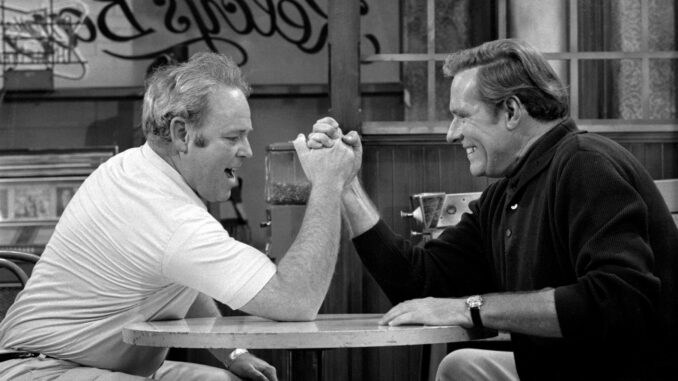
On February 9, 1971, All in the Family aired its fifth episode of season one, titled “Judging Books by Covers.” This wasn’t just another sitcom episode—it marked one of the first times a gay character was portrayed openly and sympathetically on American television.
Setting the Stage – Archie, Mike, Gloria, and Roger
-
Archie Bunker: The show’s centerpiece—outspoken, prejudiced, loud, yet in many ways human.
-
Mike (Michael Stivic) and Gloria: Archie’s liberal son-in-law and daughter, providing contrasting worldviews.
-
Roger: Mike’s friend, an effeminate photographer, whose mannerisms spark Archie’s assumptions.
Archie immediately jumps to judgment when Roger visits, making full use of stereotyped language. Mike and Gloria try to intervene. Archie’s discomfort shows just how deep stereotypes had sunk in.
Steve Enters—Expectations vs. Reality
While Roger is assumed to be gay because he is effeminate, Archie later discovers that Steve—Archie’s “he-man,” ex-football buddy, beer-drinking pal—is gay. That twist flips Archie’s assumptions on their head and challenges the audience to reassess what “gay” looks like.
Steve isn’t campy, flamboyant, or stereotypical in appearance or behavior. Instead, he’s macho, confident, “masculine,” and comfortable with himself. This portrayal was rare, especially for prime time in 1971.
Why This Was Groundbreaking

-
Breaking Stereotypes: Up to then, gay characters (if present) were often shown as caricatures or deviant tropes. Steve’s portrayal added complexity.
-
Prime Time Exposure: It wasn’t a late-night show or a fringe network—it was a network sitcom during prime time, reaching mainstream audiences.
-
Archie’s Confrontation with Homophobia: The episode forced the lead character, known for his bigotry, to face his own assumptions and prejudices. That kind of narrative arc was quite risky for the time.
The Episode’s Key Scenes and Dialogue
-
Archie judges Roger based on his manners, speech, and appearance.
-
Later, at Kelcy’s Bar, Archie meets Steve. Steve reveals he’s gay, and Archie is taken aback—not because Steve is a stereotype, but because Steve is so “opposite” of Archie’s expectations.
-
There are arm-wrestling sequences, which Archie uses both to assert dominance and to confront his discomfort. The juxtaposition of macho behavior with sexual orientation is deliberate, to expose how flawed Archie’s assumptions are.
Cultural Backlash and Impact
-
Presidential Discontent: President Richard Nixon reportedly criticized the episode, referring to it (in private tapes) as glorifying homosexuality. This shows how deeply the episode cut — not just in homes, but up to the highest levels of power.
-
Audience Reaction: The episode sparked discussions about what is seen vs. what is assumed, homophobia, and how acceptance grows—or doesn’t—through exposure.
Legacy – How “Judging Books by Covers” Influenced TV Representation
-
Many subsequent sitcoms and dramas began introducing LGBTQ characters in more nuanced ways. All in the Family blazed the trail.
-
It established that audiences could handle socially challenging topics, and TV writers could explore them without it being automatically taboo.
-
It opened doors for episodes like “Cousin Liz” (1977), another All in the Family plotline that dealt sympathetically with lesbianism.
What’s NOT Often Told
-
Roger’s character ambiguity: Roger isn’t confirmed as gay in the episode; his traits trigger assumptions, but Steve’s revelation climaxes the misunderstanding.
-
Steve’s role as a one-episode character: Even though his appearance was powerful, Steve was not a recurring character. So while the moment was historic, it was just that—a moment.
Comparison to Other Early LGBTQ TV Moments
-
Prior to this, representation of gay or lesbian characters was usually coded, or very negative, or buried in subtext. All in the Family was more direct.
-
Later shows built on this, but often cautiously. The bravery in 1971 lies in how early they tackled stereotypes so overtly.
Why Steve’s Masculinity Was Key
-
His character disrupted the “effeminate” stereotype often used to define gay men in media. By being “macho,” stable, confident, Steve defied assumptions.
-
This forced not only Archie but also the audience to rethink what “gay” can look like. It underlined that sexual orientation isn’t always obvious or stereotyped.
Relevance Today: What We Can Still Learn
-
Stereotypes persist, even today. This episode still resonates in how people assume things based on appearance or mannerisms.
-
Representation matters. When media shows diversity of LGBTQ experiences—not just caricatures—it can shift perceptions.
-
Honesty in storytelling remains powerful. All in the Family didn’t sanitize the bigotry; it confronted it. That creates room for dialogue.
Behind the Scenes – Norman Lear’s Vision
-
Created by Norman Lear (with Burt Styler writing this episode), All in the Family aimed to push boundaries in society.
-
Lear believed sitcoms could do more than just entertain—they could reflect social tensions and help audiences confront them.
-
The decision to feature Steve as gay was purposeful: to challenge Archie’s—and by extension, the audience’s—comfort with seeing people different from themselves.
Conclusion
The airing of “Judging Books by Covers” on February 9, 1971 wasn’t just a sitcom moment—it was a turning point in American television. By introducing Steve, Archie Bunker’s tough, masculine friend, as an openly gay character, All in the Family challenged deeply entrenched stereotypes. It forced its audiences to confront their own assumptions about gender, masculinity, and identity.
